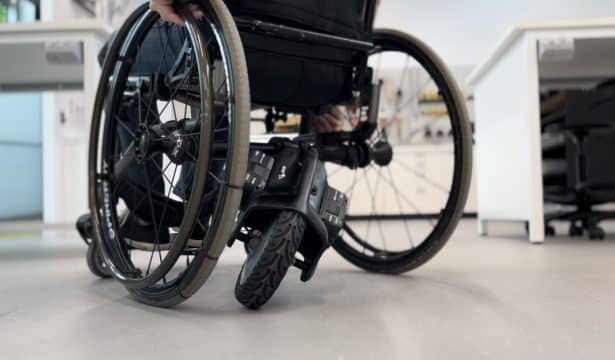
PB/5 Pedestrian Button – 2025 Livio Bonollo Award for Longevity
- Published on: 3 November 2025
Share
THE LIVIO BONOLLO AWARD FOR LONGEVITY HONOURS DESIGNS THAT ENDURE. NAMED AFTER PROFESSOR LIVIO BONOLLO, THE AWARD RECOGNISES WORK THAT STANDS THE TEST OF TIME, PROVING LONGEVITY IS ONE OF DESIGN’S GREATEST ACHIEVEMENTS.
Four decades on, the PB/5 Pedestrian Button’s rounded rectangle housing, bold arrow and satisfying push remain a constant at crossings across Australia and beyond. It is a fixture of daily life that still does its job.
Developed in the early 1980s by Nielsen Design for the NSW Roads Authority, the PB/5 brought Industrial Design, acoustics and traffic engineering into a single, resilient unit. Key figures included the late Carl Nielsen, recipient of the Australian Design Prize, lead designer David Wood and Industrial Designer Graham Paver.
Nielsen Design Director, Adam Laws, who joined the studio in 1982, sat down with Good Design Australia to reflect on why the PB/5 endures and what it teaches us about designing for the public realm.
“It was recognised from the outset as a long-life product,” Laws recalled.
“It solves the needs of its time, which haven’t changed. It’s very self-evident how to use it…you don’t have to explain it to anybody.”
A button built for anything
From the beginning, the brief was directly answering a societal need. The new assembly had to comply with the then-recent Australian Standard 2353, remove maintenance-heavy instruction plates and ‘wait’ lights, and integrate audio-tactile accessibility.
It had to survive weather, grime and human impatience. The target was a minimum of 10 million operations before failure.
Form followed function and familiarity. The housing geometry echoes the traffic signals above it, circular elements set within a rounded rectangle, a subconscious alignment that helps the unit read as part of the signal family. Sharp corners were avoided and the team explored surfaces to resist glue, paint and the general impact of the street.
The interface is deliberately simple. A large round button sits beneath a tactile arrow, so the hand never obscures the direction of travel. Consultation with blind users refined the arrow’s tactile spec into one sharp point, small enough to sit between two fingers.

Original drawing of PB/5 Pedestrian Button. Image: Supplied
Engineering the ‘feel’
The PB/5’s signature feel is not an accident. Research into long-life switches led the team to a reed switch, actuated magnetically rather than by direct physical contact. That decision decoupled user force from the electrical mechanism, protecting it from abuse and wear.
“The switch isn’t a direct contact,” Laws explained.
“It’s magnetic. It doesn’t matter how hard you hit it, that impact doesn’t transfer to the activating part of the button.”
Magnets also provide resistance and return, creating the PB/5’s characteristic ‘collapse’ action and audible click as the button meets the case. That click became an audio cue in its own right.
For many city installations, the PB/5 pairs with an audio-tactile transducer developed with acoustical engineer Louis A. Challis & Associates, a vital aid for people with vision or hearing impairment.
Its tone has slipped into culture too, you can hear that familiar beep in television grabs about road safety and it was even sampled in Billie Eilish’s song, ‘Bad Guy’.

PB/5 Pedestrian Button – mounted on the HUB Multi-Function Pole System designed by 4Design. Image: Good Design Australia
Materials and pre-vandalising
Designing for public infrastructure means designing for no owner.
Nielsen’s ethos, which Carl Nielsen described as ‘pre-vandalising’, was to leave nothing fragile to fail in the field.
The housing is metal die-cast, tough, stable and far harder to drill or cut than plastic. The original button face was solid stainless steel. They later transitioned this material into a cost-reduced thin cap over plastic, which is why some units show dents today, but they keep working. Fasteners are recessed and covers are restrained, allowing the internal components to be accessed and serviced without removing the unit from the pole.
“It has to withstand all reasonable abuse,” Laws said.
“Sun, rain, heat, grime, frustration – and it still needs to look legible and keep working.”
Practicality extends to installation. A rounded back lets the unit seat on poles of varying diameters. The arrow plate can be rotated for horizontal crossings. Critical parts were specified for interchangeability between manufacturers, supporting supply and maintenance over time.
Simple by design, longevity in practice
Simplicity is the PB/5’s greatest strength, and its hardest-won quality.
“It’s really quite a simple design,” Laws reflected.
“That is philosophically hard to do. People are tempted to add extra features that make it unreliable. Here, the balance is right. If it had been the wrong way around, someone would have replaced it.”
By resisting unnecessary styling, the PB/5 never dated. The function stayed constant and the form stayed familiar, aligning with the visual language of traffic signals rather than trends. It feels like part of the street, not something added to it.
So, why is the PB/5 still here, largely unchanged?
“Because it solved the problem properly,” Laws answered.
“It hasn’t dated by style and it hasn’t dated by technology. You could walk up to it today and not know it’s 40-plus years old.”
Longevity is sustainability in action. A product that lasts is a product that avoids the waste stream. It also protects brand reputation as public infrastructure that fails in the field is hard to forgive.
The PB/5’s durability has made it a cultural symbol, a familiar shape you don’t think about until the beep cuts through the street noise and you step off the curb.

PB/5 Pedestrian Button – 2025 Livio Bonollo Award for Longevity. Image: Supplied
Lessons for today’s designers
Laws is clear on what contemporary teams can take from the PB/5.
Get the brief right. Understand user behaviour, including misuse. Specify materials and finishes for the true environment, not the ideal one. Resist unnecessary features. Keep costs sensible, but not at the expense of reliability. And design for service: fasteners, access, interchangeable wear parts.
“Once it’s in the field, nothing destroys reputation faster than failure,” he said.
“Public infrastructure must be robust because nobody owns it. Most people respect it, but the 10% who don’t are too many.”
Identity and impact
For Nielsen Design, the PB/5 has also become a clear way to explain Industrial Design to the public: a tangible, everyday example of how design shapes behaviour, safety and experience.
“It’s actually been good for us,” Laws reflected.
“When someone asks ‘What’s Industrial Design?’, we show them the pedestrian crossing button. Then people get it.”
The PB/5 shows what happens when design is clear, honest and built for the real world. Its die-cast housing and magnetic switch mean you can strike it, lean on it or hit it in a hurry, and it will keep working, year after year, in heat, rain and constant use.
The accessibility features, the tactile arrow, the audio cue and the natural placement of the hand are all part of why it will continue to be effective.
Its form sits comfortably within the streetscape.
And, unbeknownst to us, it has become part of daily life, pressed on the way to school with mates, to work, to dinner with someone you love. A small gesture repeated millions of times. Its sound and silhouette sit somewhere in the back of our mind, something familiar and quietly sharing how we move through the city.
Good Design Australia congratulates and thanks Nielsen Design and the many collaborators behind the PB/5 Pedestrian Button, and acknowledges the original team, including Carl Nielsen and David Wood, for a design that continues to make cities safer, clearer and more human.
A special thank you also to Edward Khoury from Form Designs for initiating this Special Accolade in honour of Professor Elivio Bonollo AM


